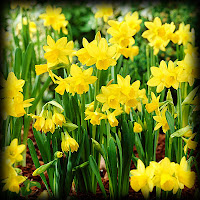Daffodils are the classic heralds of spring. They
bring an element of surprise and excitement
each year as gardeners eagerly await their
emergence from the soil, closely followed by
their breathtaking floral performance.
Daffodils are easy to look after in the Garden
· They grow in full sun to semi-shade but do best in a position with sun during winter and spring, when they bloom.
· Daffodils also need plenty of sun when they've just finished flowering, as this is when the bulbs are taking in energy for the following year's display.
· While they are dormant, daffodils should be left un-watered. If your summer climate is wet or soil is poorly drained, they can be lifted and stored in a cool, dark place and replanted in autumn. Otherwise they can be left to grow and multiply.
· Daffodils are extremely drought hardy, however, to have them performing at their best I advise to mulch well.
· Resist the temptation to pull off or cut back leaves before daffodils have died down completely. Leaving them allows the goodness to return to the bulb in preparation for next season's flowering.
Daffodils are easy to look after in the Pots
· The main key to success with daffodils in pots is to choose suitable bulb varieties, which are sturdy and not too tall, such as "tete a tete"
· Always use a well-drained potting mix or a potting mix that has been designed especially for bulbs.
· If you do bring pots of daffodils inside and you wish to keep the bulbs growing for as long as possible, place them in a cool position in the house, away from any heaters.
· To have these pots of daffodils looking great year after year, it's necessary to renew the potting mix with slow release fertilizer and wetting agent annually, or to replant your bulbs into new potting mix.
· Alternatively plant the bulbs into the garden after they've finished flowering, and replace them with new daffodil bulbs the following season.
Daffodils are versatile
· Daffodils suit all styles of gardens, whether cottage or formal, small or large, and they can even be used successfully in contemporary settings.
· Grow them in clumps in the garden, as borders, in containers, mass plant them in drifts, or let them naturalise - whichever way, they look stunning.
· They are an ideal choice as an under-planting for deciduous trees that are bare-stemmed in winter.
· Growing daffodils in pots enables you to show off the plants while they're looking their best, then move them to a less prominent position while they're not putting on a show.
· Dwarf Daffodils such as "tete a tete" look great in pots!
So there you have it. Daffodils look great, they're tough as nails, and they're even cheap to buy!





